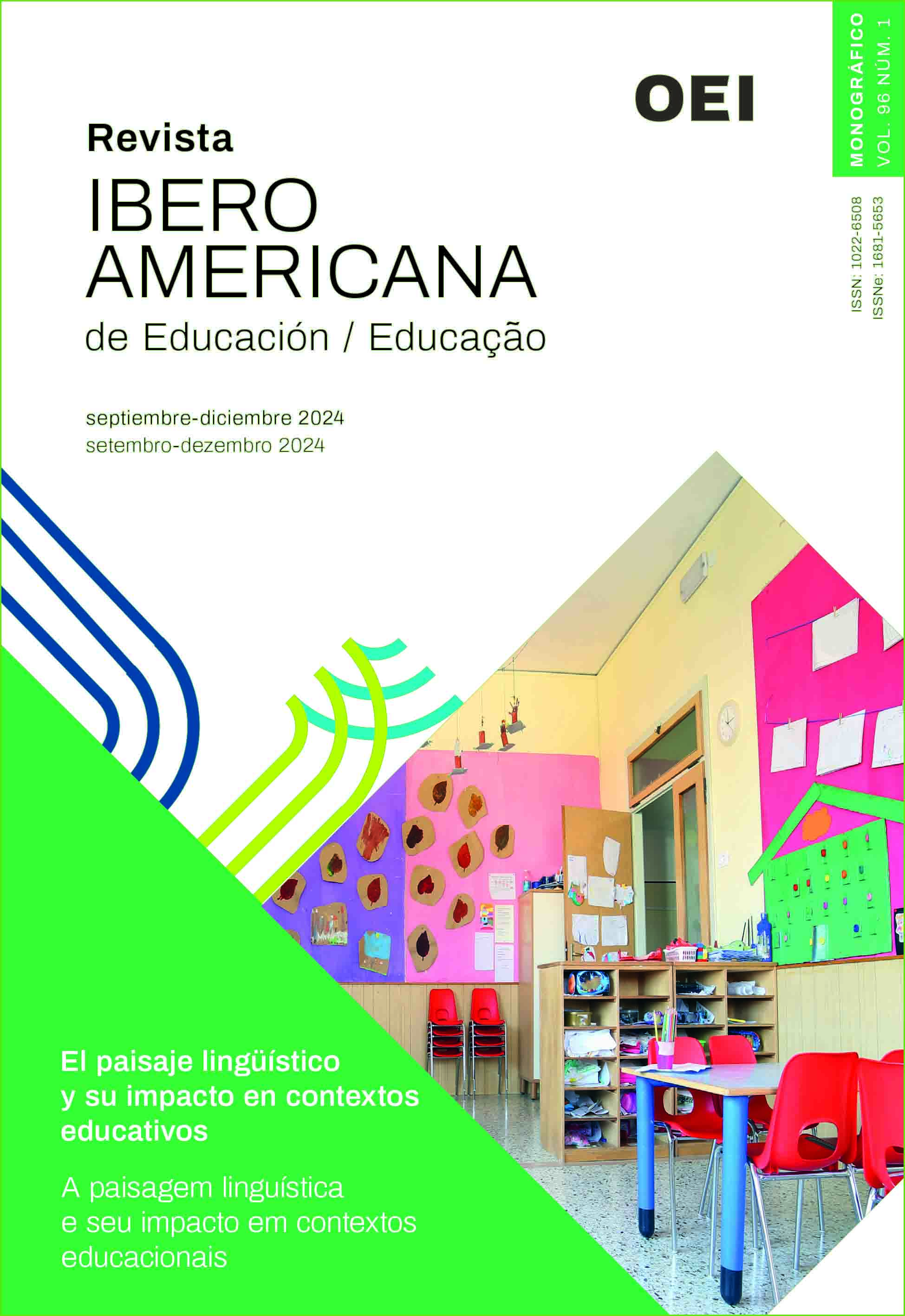Linguistic landscape in Bilingual Intercultural Education schools in Peru
DOI:
https://doi.org/10.35362/rie9616436Keywords:
linguistic landscape, bilingual education, indigenous languagesAbstract
The Ministry of Education of Peru establishes that Intercultural Bilingual Education (IBE) schools train students who will be able to communicate in indigenous language and Spanish at the end of their school period. Furthermore, in secondary school, the learning of English is included, generating a multilingual context for learners. Generally, within the framework of bilingual/multilingual education, schools raise the visibility of languages in the schoolscape. Following this perspective, a small investigation was carried out in 25 IBE schools in Peru, with the purpose of identifying the use of languages and their combination in the linguistic landscape. The results show, on the one hand, that the majority only uses the Indigenous Language in the linguistic landscape within the classroom, in a small space designated for it. Outside that area, only Spanish is used. On the other hand, schools that do use the Indigenous Language in different spaces do so to name some elements of the context, they rarely use it to provide another type of message. Likewise, in none of the cases were official communications found in the indigenous language. In this way, it is concluded that there is a limited understanding about the impact of the linguistic landscape on education.
Downloads
References
Aladjem, R. y Jou, B. (2016). The linguistic landscape as a learning space for contextual language learning. Journal of Learning Spaces, 5(2), 66-70.
Bernardo-Hinesley, S. (2020). Linguistic landscape in educational spaces. Journal of Culture and Values in Education, 3(2), 13-23. DOI: https://doi.org/10.46303/jcve.2020.10
Bisai, S. y Singh, S. (2022). Language visibility in multilingual schools: An empirical study of schoolscapes from India. Linguistics and Education, 69, 101046. DOI: https://doi.org/10.1016/j.linged.2022.101046
Brown, K.D. (2005). Estonian schoolscapes and the marginalization of regional identity in education. European Education 37, 78–89. DOI: https://doi.org/10.1080/10564934.2005.11042390
Brown, K. D. (2012). The linguistic landscape of educational spaces: Language revitalization and schools in southeastern Estonia. In Minority languages in the linguistic landscape (pp. 281-298). London: Palgrave Macmillan UK. DOI: https://doi.org/10.1057/9780230360235_16
Cenoz, J. y Gorter, D. (2008). El estudio del paisaje lingüístico. On-line on Hizkunea website. https://cutt.ly/CeYp8mpy
Córdova-Hernández, L. y Yataco, M. (2019). Paisajes en lenguas indígenas latinoamericanas: representaciones, reivindicaciones y consumo. Signo y seña, (35), 88-108. DOI: https://doi.org/10.34096/sys.n35.6939
Gorter, D. y Cenoz, J. (2024). A panorama of linguistic landscape studies. Bristol; Jackson: Multilingual Matters. https://doi.org/10.21832/GORTER7144. DOI: https://doi.org/10.21832/9781800417151
Krompák, E., Fernández-Mallat, V., & Meyer, S. (2022). The symbolic value of educationscapes–Expanding the intersections between linguistic landscape and education. Linguistic landscapes and educational spaces, 1-27. DOI: https://doi.org/10.21832/9781788923873-003
Kubiak, E. (2019). Apu, kausachun y Tawantinsuyo. Quechuismos en los nombres propios de los movimientos políticos regionales. En el margen de los estudios sobre el paisaje lingüístico cusqueño. Voces dialogantes. Estudios en homenaje al professor Wiaczesław Nowikow. Wydawnictwo Uniwersytetu Łódzkiego. http://dx.doi.org/10.18778/8142-564-3.34. DOI: https://doi.org/10.18778/8142-564-3.34
Landry, R. y Bourhis, R. Y. (1997). Linguistic Landscape and Ethnolinguistic Vitality: An Empirical Study. Journal of Language and Social Psychology, 16(1), 23-49. https://doi.org/10.1177/0261927X970161002 DOI: https://doi.org/10.1177/0261927X970161002
Ministerio de Cultura del Perú. (2021). Guía para la implementación de señalética en lenguas indígenas u originarias. https://cutt.ly/GeYp30LN
Ministerio de Educación del Perú. (2013). Documento Nacional de Lenguas Originarias del Perú. Versión resumida. https://bit.ly/3b5zRP2
Ministerio de Educación del Perú. (2015). Guía de Diseño de Espacios Educativos – Acondicionamiento de locales escolares al nuevo modelo de Educación Básica Regular. Primaria y Secundaria. https://cutt.ly/8eYp3WVV
Ministerio de Educación del Perú. (2018a). Lenguas Originarias del Perú. https://bit.ly/3omQ9Gh
Ministerio de Educación del Perú. (2018b). Modelo de Servicio Educativo Intercultural Bilingüe. Recuperado el 12 de febrero de 2021, del Repositorio del Ministerio de Educación. https://cutt.ly/DeYp9Ndq
Ministerio de Educación del Perú. (2021). ¿Cómo orientamos el proceso de apropiación del código escrito en lengua originaria como lengua materna?. https://cutt.ly/GeYp9Wt8
Ministerio de Educación del Perú. (s.f.). Espacios Educativos: Ambientes pensados para nuestros bebés, niñas y niños. hhttps://cutt.ly/0eYp2P67
Moustaoui, A. (2019). Dos décadas de estudios del Paisaje Lingüístico: enfoques teórico-metodológicos y nuevos desafíos en la investigación. Signo y seña, (35), 7-28. DOI: https://doi.org/10.34096/sys.n35.6935
Perú (2016). Decreto Supremo N.° 004-2016-MC. Decreto Supremo que aprueba el Reglamento de la Ley N° 29735, Ley que regula el uso, preservación, desarrollo, recuperación, fomento y difusión de las lenguas originarias del Perú. Presidencia de la República del Perú. https://cutt.ly/oeYp8pNh
Shohamy, E. (2015). LL research as expanding language and language policy. Linguistic Landscape, 1(1-2), 152-171. DOI: https://doi.org/10.1075/ll.1.1-2.09sho
Shohamy, E. and Waksman, S. (2009) Linguistic landscape as an ecological arena: Modalities, meanings, negotiations, education. In E. Shohamy and D. Gorter (eds) Linguistic Landscape: Expanding the Scenery (pp. 313-331). New York: Routledge. DOI: https://doi.org/10.4324/9780203930960
How to Cite
Published
Issue
Section
License
Copyright (c) 2024 Iberoamerican Journal of Education

This work is licensed under a Creative Commons Attribution 4.0 International License.
Any authors who publish with this journal accept the following terms:















